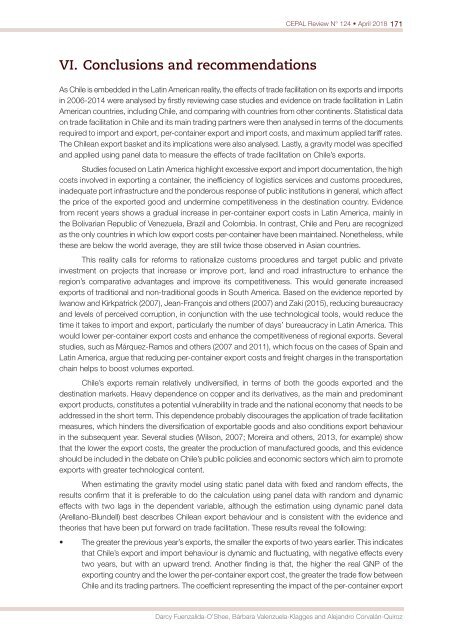CEPAL Review no. 124
April 2018
April 2018
Create successful ePaper yourself
Turn your PDF publications into a flip-book with our unique Google optimized e-Paper software.
<strong>CEPAL</strong> <strong>Review</strong> N° <strong>124</strong> • April 2018 171<br />
VI. Conclusions and recommendations<br />
As Chile is embedded in the Latin American reality, the effects of trade facilitation on its exports and imports<br />
in 2006-2014 were analysed by firstly reviewing case studies and evidence on trade facilitation in Latin<br />
American countries, including Chile, and comparing with countries from other continents. Statistical data<br />
on trade facilitation in Chile and its main trading partners were then analysed in terms of the documents<br />
required to import and export, per-container export and import costs, and maximum applied tariff rates.<br />
The Chilean export basket and its implications were also analysed. Lastly, a gravity model was specified<br />
and applied using panel data to measure the effects of trade facilitation on Chile’s exports.<br />
Studies focused on Latin America highlight excessive export and import documentation, the high<br />
costs involved in exporting a container, the inefficiency of logistics services and customs procedures,<br />
inadequate port infrastructure and the ponderous response of public institutions in general, which affect<br />
the price of the exported good and undermine competitiveness in the destination country. Evidence<br />
from recent years shows a gradual increase in per-container export costs in Latin America, mainly in<br />
the Bolivarian Republic of Venezuela, Brazil and Colombia. In contrast, Chile and Peru are recognized<br />
as the only countries in which low export costs per-container have been maintained. Nonetheless, while<br />
these are below the world average, they are still twice those observed in Asian countries.<br />
This reality calls for reforms to rationalize customs procedures and target public and private<br />
investment on projects that increase or improve port, land and road infrastructure to enhance the<br />
region’s comparative advantages and improve its competitiveness. This would generate increased<br />
exports of traditional and <strong>no</strong>n-traditional goods in South America. Based on the evidence reported by<br />
Iwa<strong>no</strong>w and Kirkpatrick (2007), Jean-François and others (2007) and Zaki (2015), reducing bureaucracy<br />
and levels of perceived corruption, in conjunction with the use tech<strong>no</strong>logical tools, would reduce the<br />
time it takes to import and export, particularly the number of days’ bureaucracy in Latin America. This<br />
would lower per-container export costs and enhance the competitiveness of regional exports. Several<br />
studies, such as Márquez-Ramos and others (2007 and 2011), which focus on the cases of Spain and<br />
Latin America, argue that reducing per-container export costs and freight charges in the transportation<br />
chain helps to boost volumes exported.<br />
Chile’s exports remain relatively undiversified, in terms of both the goods exported and the<br />
destination markets. Heavy dependence on copper and its derivatives, as the main and predominant<br />
export products, constitutes a potential vulnerability in trade and the national eco<strong>no</strong>my that needs to be<br />
addressed in the short term. This dependence probably discourages the application of trade facilitation<br />
measures, which hinders the diversification of exportable goods and also conditions export behaviour<br />
in the subsequent year. Several studies (Wilson, 2007; Moreira and others, 2013, for example) show<br />
that the lower the export costs, the greater the production of manufactured goods, and this evidence<br />
should be included in the debate on Chile’s public policies and eco<strong>no</strong>mic sectors which aim to promote<br />
exports with greater tech<strong>no</strong>logical content.<br />
When estimating the gravity model using static panel data with fixed and random effects, the<br />
results confirm that it is preferable to do the calculation using panel data with random and dynamic<br />
effects with two lags in the dependent variable, although the estimation using dynamic panel data<br />
(Arella<strong>no</strong>-Blundell) best describes Chilean export behaviour and is consistent with the evidence and<br />
theories that have been put forward on trade facilitation. These results reveal the following:<br />
• The greater the previous year’s exports, the smaller the exports of two years earlier. This indicates<br />
that Chile’s export and import behaviour is dynamic and fluctuating, with negative effects every<br />
two years, but with an upward trend. A<strong>no</strong>ther finding is that, the higher the real GNP of the<br />
exporting country and the lower the per-container export cost, the greater the trade flow between<br />
Chile and its trading partners. The coefficient representing the impact of the per-container export<br />
Darcy Fuenzalida-O’Shee, Bárbara Valenzuela-Klagges and Alejandro Corvalán-Quiroz


















